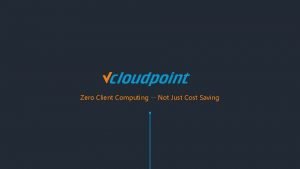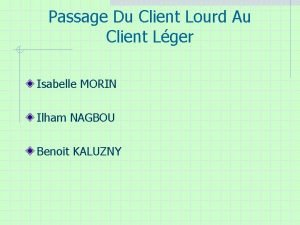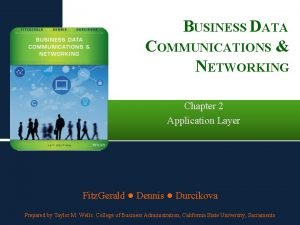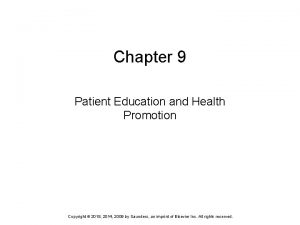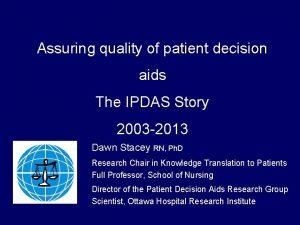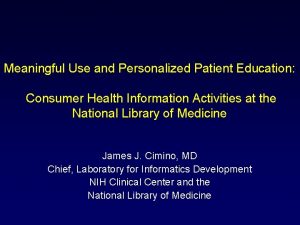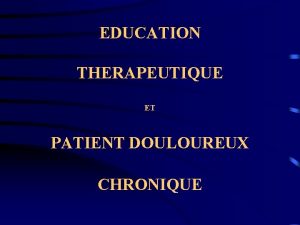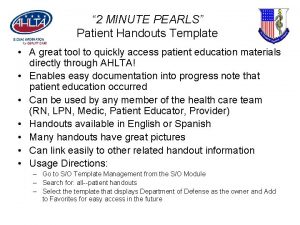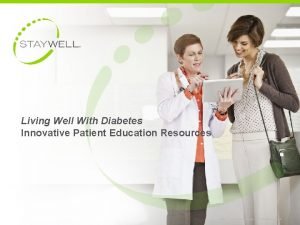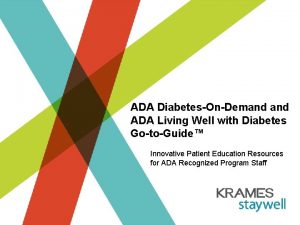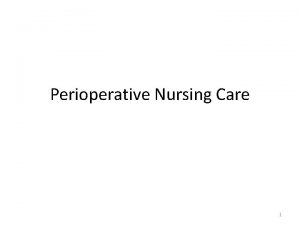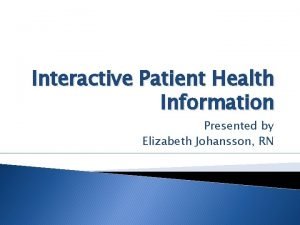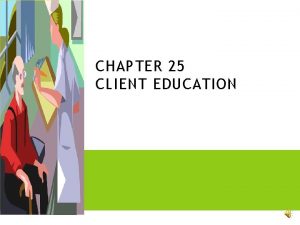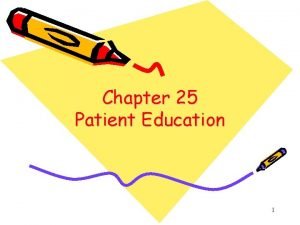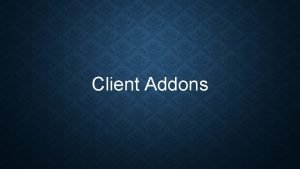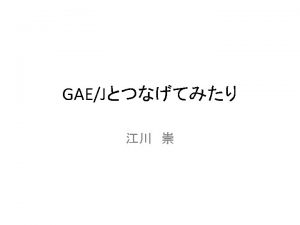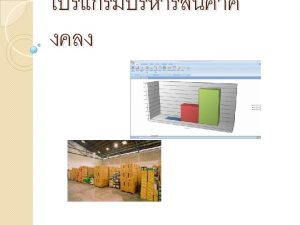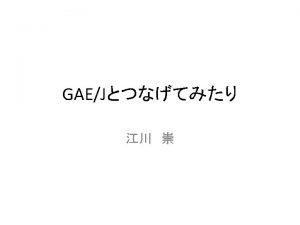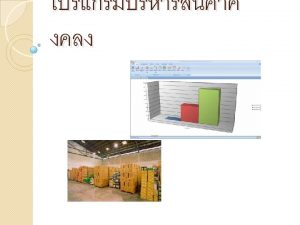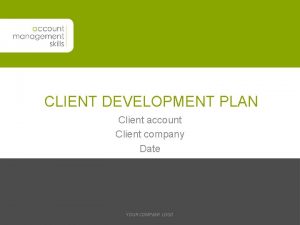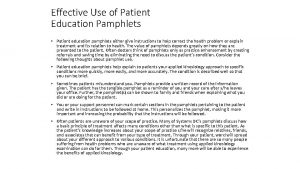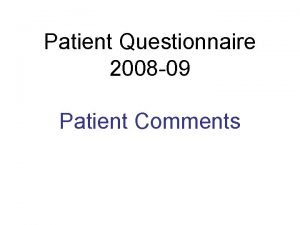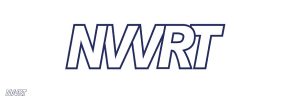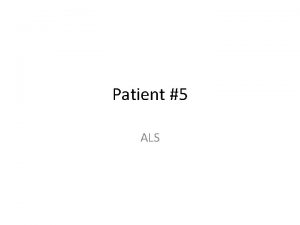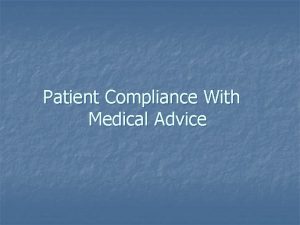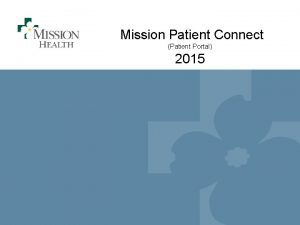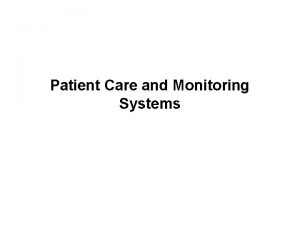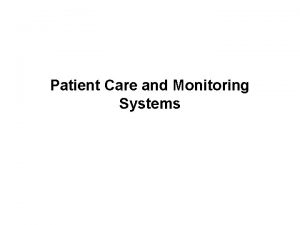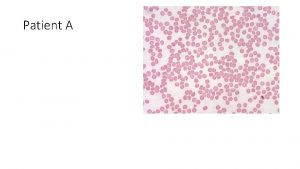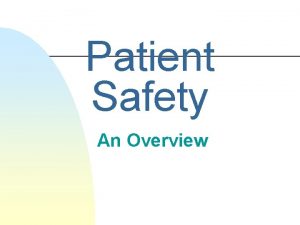Chapter 25 Patient Education 1 Standards for Client
























- Slides: 24

Chapter 25 Patient Education 1

Standards for Client Education • The Joint Commission sets standards for client and family education. • Successful accomplishment of standards requires collaboration among health care professionals. • All state Nurse Practice Acts recognize that patient teaching falls within the scope of nursing practice. 2

Purpose of Client Education • To help individuals, families, or communities achieve optimal levels of health • Patient education includes: – Maintenance and promotion of health and illness prevention – Restoration of health – Coping with impaired functioning 3

Teaching and Learning • Teaching – An interactive process that promotes learning • Learning – The purposeful acquisition of knowledge, skills, behaviors, and attitudes 4

Role of the Nurse in Teaching and Learning Teach information that the patient and the family need to make informed decisions regarding their care. Determine what patients need to know. Identify when patients are ready to learn.

TJC’s Speak Up Tips • Speak up if you have questions or concerns. • Pay attention to the care you get. • Educate yourself about your illness. • Ask a trusted family member or friend to be your advocate. • Know which medicines you take and why. • Use a health care organization that has been carefully evaluated. • Participate in all decisions about your treatment.

Teaching as Communication • Closely parallels the communication process. • Depends in part on effective interpersonal communication. • The learning objective describes what the learner will be able to accomplish after instruction is given. 7

Domains of Learning Cognitive Includes all intellectual behaviors and requires thinking Affective Deals with expression of feelings and acceptance of attitudes, opinions, or values Psychomotor Involves acquiring skills that require integration of mental and muscular activity Copyright line.

Quick Quiz! 1. A patient newly diagnosed with diabetes needs to learn how to use a glucometer. Use of a glucometer constitutes A. Affective learning. B. Cognitive learning. C. Motivational learning. D. Psychomotor learning. 25 - 9

Domains of Learning • Different teaching methods are appropriate for each domain of learning. • Cognitive: discussion (one-on-one or group), lecture, question-and-answer session, role play, discovery, independent project, field experience • Affective: role play, discussion (one-onone or group) • Psychomotor: demonstration, practice, return demonstration, independent projects, games

Basic Learning Principles • Motivation to learn: addresses the client’s desire or willingness to learn • Ability to learn: depends on physical and cognitive abilities, developmental level, physical wellness, thought processes • Learning environment: allows a person to attend to instruction 11

Ability to Learn • Adult learning – Self-directed – Patient-centered • Physical capability – Level of personal development – Physical health – Fatigue

Learning Environment Well lit Good ventilation Appropriate furniture Comfortable temperature Quiet Private

Integrating the Nursing and Teaching Process • A relationship exists. • The nursing and teaching process are not the same. • The nursing process requires assessment of all data. • The teaching process focuses on the client’s learning needs and ability to learn. • When education becomes part of the care plan, the teaching process begins. 14

Nursing Process: Assessment • See through the patient’s eyes. – Teaching is patient-centered. • Assess the patient’s learning needs. • Ask questions to identify motivation to learn. • Determine the patient’s physical and cognitive ability to learn. • Provide an appropriate teaching environment. • Assess the readiness and ability of a family caregiver or other learning resource. • Assess health literacy/learning disabilities.

Nursing Process: Assessment ( • Health literacy: the cognitive and social skills that determine the motivation and ability of individuals to gain access to, understand, and use information in ways that promote and maintain good health. • Health literacy includes patients’ reading and mathematics skills, comprehension, and decision-making and functioning skills with regard to health care.

Nursing Process: Nursing Diagnosis • Nursing diagnoses for patient education – Deficient knowledge (affective, cognitive, psychomotor) – Ineffective health maintenance – Impaired home maintenance – Ineffective family therapeutic regimen management – Ineffective self-health management – Noncompliance (with medications)

Nursing Process: Planning • Determine goals and expected outcomes that guide the choice of teaching strategies and approaches with a patient: – – Set priorities. Select timing to teach. Organize the teaching materials. Use teamwork and collaboration.

Nursing Process: Implementation • Maintain learning attention and participation. • Build on existing knowledge. • Select teaching approach. • Incorporate teaching with nursing care.

Nursing Process: Implementation (cont’d) • Select appropriate instructional methods: – – – – Group instruction One-on-one discussion Preparatory instruction Demonstration Analogy Role playing Simulation

Nursing Process: Implementation (cont’d) • Illiteracy and other disabilities • Cultural diversity • Using different teaching tools • Special needs of children and older adults

Quick Quiz! 2. During a teaching session, the nurse tells a patient with a recent neck injury that damage to the nerves is comparable to a water hose that has been pinched off. During this teaching session, the nurse is using the process of A. Analogy. B. Discovery. C. Role playing. D. Demonstration. 25 - 22

Nursing Process: Evaluation • See through the patient’s eyes. – Have the patient’s learning needs been met? • Evaluate a patient’s learning by observing performance of expected learning behaviors under desired conditions. • Discontinue, adjust, or amend the plan. • Patient outcomes: – Legal responsibility – Documentation

This work is licensed under a Creative Commons Attribution 4. 0 International License. Except where otherwise noted, this content by Southern Regional Technical College is licensed under the Creative Commons Attribution 4. 0 International License. To view a copy of this license, click https: //creativecommons. org/licenses/by/4. 0/ Healthcare Careers Work!(HCW) is sponsored by a $2. 3 million grant from the U. S. Department of Labor, Employment & Training Administration. TAACCCT Grant #TC- 26488 -14 -60 -A-13. Southern Regional Technical College is an equal opportunity employer and will make adaptive equipment available to persons with disabilities upon request. This workforce product was funded by a grant awarded by the U. S. Department of Labor’s Employment and Training Administration. The product was created by the grantee and does not necessarily reflect the official position of the U. S. Department of Labor. The U. S. Department of Labor makes no guarantees, warranties, or assurances of any kind, express or implied, with respect to such information, including any information on linked sites and including, but not limited to, accuracy of the information or its completeness, timeliness, usefulness, adequacy, continued availability, or ownership.
 V cloud point s100
V cloud point s100 Client lourd vs client léger
Client lourd vs client léger Example of two tier architecture
Example of two tier architecture Patient 2 patient
Patient 2 patient Patient readiness to learn
Patient readiness to learn Ipdas
Ipdas Customer defined service standards
Customer defined service standards Personalized patient education
Personalized patient education éducation du patient définition
éducation du patient définition Patient education handout template
Patient education handout template Living well with diabetes krames patient education
Living well with diabetes krames patient education Living well with diabetes workbook merck
Living well with diabetes workbook merck Preoperative patient education ppt
Preoperative patient education ppt X-plain patient education
X-plain patient education Kontinuitetshantering
Kontinuitetshantering Typiska novell drag
Typiska novell drag Nationell inriktning för artificiell intelligens
Nationell inriktning för artificiell intelligens Vad står k.r.å.k.a.n för
Vad står k.r.å.k.a.n för Varför kallas perioden 1918-1939 för mellankrigstiden
Varför kallas perioden 1918-1939 för mellankrigstiden En lathund för arbete med kontinuitetshantering
En lathund för arbete med kontinuitetshantering Personalliggare bygg undantag
Personalliggare bygg undantag Personlig tidbok
Personlig tidbok Anatomi organ reproduksi
Anatomi organ reproduksi Densitet vatten
Densitet vatten Datorkunskap för nybörjare
Datorkunskap för nybörjare
